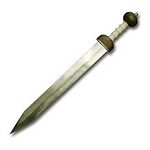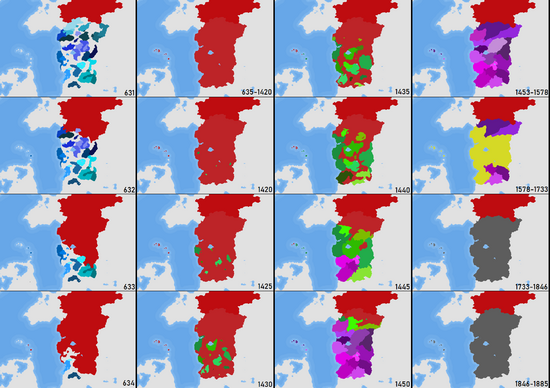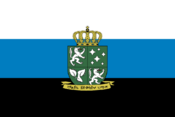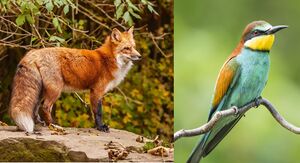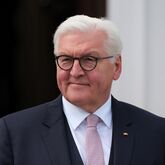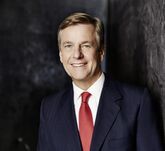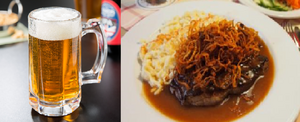New Sebronia
Federal Republic of New Sebronia Federirepaluike Navæ Sebroni | |
|---|---|
| Motto: Bargen, Wæsuten e Marien soes verent, kil ge Demiisma zen tei regantei! "Mountains, deserts and seas are united for democracy to rule over them!" | |
| Anthem: Hymn of Unity | |
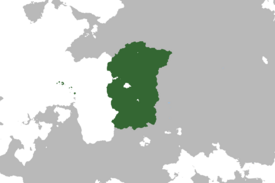 | |
| Capital and largest city | Haæstre |
| Official languages | Traditional Sebric Modern Sebric |
| Recognised national languages | Kuhnatalsahri |
| Ethnic groups | Germanic 54,45% Batrec 34,73% Kuhnat Alsahra 2.69% Pikreshii 0.21% Others (foreign) 7,92% |
| Demonym(s) | Sebric(s) |
| Government | Federal democratic parliamentary Republic |
• Federal President | Benjamin Tenichi, LdM (since 2016) |
• Federal Chancellor | Laonie Terisēa, SGP (since 2020) |
| Legislature | Sebric Parliament |
| Federal Council | |
| Federal Assembly | |
| Establishment | |
• Invasion of early sebric Kingdoms by the Goraboese Empire | 632-635 |
• Independence of new sebric kingdoms during the 30-year Rebellion | 1445-1453 |
• Declaration of the Alaris Confederation | 1578 |
• Establishment of the Sebric Empire | 1733 |
• Declaration of the Federal Republic | May 14th 1912 |
| Area | |
• Total | 1,587,396 km2 (612,897 sq mi) |
| Population | |
• 2020 estimate | 91,530,000 |
• 2019 census | 91,150,316 |
• Density | 57.42/km2 (148.7/sq mi) |
| GDP (PPP) | 2020 estimate |
• Total | 4.039 Trillion ACU |
• Per capita | 44,123 ACU |
| GDP (nominal) | 2020 estimate |
• Total | 3.846 Trillion ACU |
• Per capita | 42,022 ACU |
| Gini (2019) | low |
| HDI (2019) | very high |
| Currency | Bateræ (せ) (BTR) |
| Time zone | UTC-4 |
• Summer (DST) | UTC-4 (not observed) |
| Date format | dd-mm-yyyy |
| Driving side | right |
| Calling code | +420 |
| ISO 3166 code | NSB |
| Internet TLD | .nsb |
New Sebronia (Sebric: Navæ Sebroni), officially the Federal Republic of New Sebronia (Sebric: Federirepaluike Navæ Sebroni), is a federal democratic parliamentary republic, led by the current Federal President Benjamin Tenichi as the head of state and the Federal Chancellor Laonie Terisea as the head of government, and is located on the western coast of Thrismari. It is devided into a total of 17 partly-souvereign constituent states (Sebric: Federisteta "Federal State"), and with the capital city of Haæstre, as well as the two coastal cities of Deimeka and Den Edeldec as its major trade hubs, New Sebronia is considered one of the biggest economies of the continent, as well as one of the most environmentally friendly and stunning countries on Anteria.
History
The first Batri-tribes
The first known settlements in today's Sebronia established in the 4th-5th century, mostly in the warm, flat areas in northern Minnlande and Suchiron. That was also the time the first batrecist scripts were written in the Ledaæri mountains. Those tribes quickly developed to kingdoms, fighting each other for land, ressources, and power in the region. Not much is known about how the early tribes lived, as much got destroyed, propably during the times of war. What is known, is that they lived in primitive wooden structures for a long time, and were mostly farmers, using the flat lands to grow food.
Invasion by the Goraboese Empire
In 632-635, the Goraboese Empire invaded Sebronia during their conquest. Their efficient and fast tactics in addition to their equipment made them superior in almost every aspect. The seperate kingdoms were in war between each other, not realising the threat, and were simply overrunned. The most resisting were the southern kingdoms, as well as the kingdoms in the mountains, trying to protect their batrecist temples and artifacts. Many of those were destroyed in the fights, and the kingdoms had to surrender.
Not only the mainland was conquered, but also the Marigemi Islands, which the coastal Kingdom of Nemanin tried to colonize during the invasion until they also had to surrender. Many settlements got heavily damaged, and the casualties were high.
After the caliphate conquered all of today's Sebronia, all the kingdoms officially fell and became a semi-autonomous province of Gorabo. Though the life as a mere province was not liked, the Province of Sebronia was the first ever governmental entity uniting the former sebric kingdoms to a combined Sebronia, and the sebric people had the feeling of unity for the first time ever.
Sebronia as goraboese province
During 785 years as a province, the life of sebric citizens in Gorabo was not hard, but the Empire had strict regulations and rules in the means of religion. Though local languages and cultures were still mostly intact, the conversion to Islam was incentivized and it became a state religion. With the Goraboese Empire building mosques in the major cities, and technically turning Sebronia into a muslim state, Batrecism and other minority religions native to Sebronia were almost oppressed, which was a hard punch in the gut for believing Sebrics. The original cultural and religious differences were too big for the natives to be fully integrated into Gorabo, and in 1439, the first revolts broke out.
The Thirty Years' Rebellion
In 1420, the situation escalated. In a settlement in today's Haæstre, native sebric citizens went on an insurgency, protesting for more equality for all religions, as well as total freedom from the caphilate. The insurgency was stuck down by Gorabo, though when the message of the it spread through the land, other settlements and towns also begun revolting. The sheer mass of insurgents was overwhelming, and the insurgency turned into a rebellion, one that lasted for 33 years. While the rebellionists' territory got bigger and bigger over the years, more and more other rebellion groups arised. The caliphate was fighting back, though this time, the Sebrics united, and with stolen weapons from goraboese military storehouses, managed to gain more and more power and the Empire lost more and more land. While the rebellion was still ongoing in the north, and many rebellion groups joined forces, the first new kingdoms and republics established in the south, for example the Kingdom of Keristeira, the Kingdom of Soniset, and the Republic of Meontes.
In 1453, the caliphate had to accept the independency of the new sebric states and the rebllion came to and end, with many casualties to mourn for.
Alaris Confederation/Confederacy of Alaris
After the independence from Gorabo, many sebric states established a defense alliance, hoping that the joined forces will protect them from another invasion by Gorabo. This also led to a feeling of unity between the states, and for the first time ever in sebric history, Sebronia lived in peace. In 1578, King Florin II. of the Constitutional Kingdom of Alaris, suggested establishing a stronger binding union, not only being able to defend itself better against Gorabo, but also becoming a strong economic powerhouse. This included a common currency and partly common market, a joint military, a sebric parliament and . With 10 of the 15 states agreeing, on February 5th 1578, the Alaris Confederation, named after the founder state, was declared. The Alaris Confederation is the first united sebric state and considered one of the first democratic states with democratic constitution, with an almost modern-like federal governmental system, and with same rights for everyone, including homo- and bisexuality, gender and religion defined in the confederate constitution.
Sebric Empire
TBA
The Sebric Revolution
TBA
Fall of the Empire
TBA
Federal Republic of New Sebronia
TBA
Geography
New Sebronia is on the Marigic Gulf on the western coast of Thrismari, bordering Basilund and Gorabo to the north and Kynasta to the south. Besides the big mainland, New Sebronia also possesses an island group called the Marigemi Islands in the gulf itself.
Being over 1.5 Million square kilometers big, New Sebronia has mostly flat terrain, with the only rough highlands being in the east, where the big Ledaæri mountain range marks the national border. Those mountains go up to over 6,000 meters above sea level, as for example the Kaiserpoeka, the highest peak in New Sebronia with 6,217m above sea level.
Climate
For the biggest part, New Sebronia is in a temparate and mediterranean area, which - together with the flat terrain - is the reason for the high niveau of agriculture practiced there, which is blessed by the good precipitation in New Sebronia, reaching from 43 to 107 litres per square meter, with little to no extremes during the expected cycle through the year. Because the population, and with it the pollution, growths bigger year by year, the sebric government already has enacted many environment-protecting laws and guidelines to reduce the growth of pollution and non-recycable waste. An example of this is the high use of wind turbines, for which the flat, temperate lands are perfect, but also photovoltaics have proven themselves useful. Temperatures in this areas are mostly mild, with an average of 20°C during summer and 3°C during winter, though in the south temperatures can get much lower during winter, while in the north the temperatures tend to get higher than average.
In the north a big semi-arid desert called the Elskermi Desert streches across New Sebronia, making up almost 30% of the total land area. Though it is not totally unhabitable, only approx. 1.6 Million people live in the desert. The mostly rocky, loose ground makes it impossible to grow food, so the only towns and cities are almost always located on three rivers, all merging together to the Terione River in the west. Those are the only way to trade and import goods.
| Climate data for Navæ Bariken, Minnlande (1989-2019) | |||||||||||||
|---|---|---|---|---|---|---|---|---|---|---|---|---|---|
| Month | Jan | Feb | Mar | Apr | May | Jun | Jul | Aug | Sep | Oct | Nov | Dec | Year |
| Record high °C (°F) | 37.2 (99.0) |
32.6 (90.7) |
30.3 (86.5) |
26.1 (79.0) |
22.5 (72.5) |
16.7 (62.1) |
13.2 (55.8) |
14.5 (58.1) |
25.3 (77.5) |
29.9 (85.8) |
34.2 (93.6) |
36.8 (98.2) |
37.2 (99.0) |
| Average high °C (°F) | 26.4 (79.5) |
24.2 (75.6) |
20.4 (68.7) |
15.2 (59.4) |
11.8 (53.2) |
8.5 (47.3) |
7.8 (46.0) |
9.7 (49.5) |
12.8 (55.0) |
18.7 (65.7) |
22.7 (72.9) |
25.6 (78.1) |
17.0 (62.6) |
| Daily mean °C (°F) | 20.9 (69.6) |
18.2 (64.8) |
15.0 (59.0) |
11.1 (52.0) |
7.3 (45.1) |
3.9 (39.0) |
3.0 (37.4) |
4.4 (39.9) |
8.3 (46.9) |
12.5 (54.5) |
16.9 (62.4) |
20.5 (68.9) |
11.8 (53.3) |
| Average low °C (°F) | 15.3 (59.5) |
12.1 (53.8) |
9.6 (49.3) |
6.9 (44.4) |
2.7 (36.9) |
−0.7 (30.7) |
−1.8 (28.8) |
−0.9 (30.4) |
3.7 (38.7) |
6.3 (43.3) |
11.1 (52.0) |
15.4 (59.7) |
6.6 (44.0) |
| Record low °C (°F) | 10.9 (51.6) |
8.8 (47.8) |
7.0 (44.6) |
4.4 (39.9) |
−2.5 (27.5) |
−4.7 (23.5) |
−5.2 (22.6) |
−3.3 (26.1) |
−1.2 (29.8) |
4.1 (39.4) |
7.8 (46.0) |
10.0 (50.0) |
−5.2 (22.6) |
| Average precipitation mm (inches) | 43.8 (1.72) |
59.8 (2.35) |
89.5 (3.52) |
107.2 (4.22) |
96.2 (3.79) |
92.4 (3.64) |
81.8 (3.22) |
92.6 (3.65) |
80.0 (3.15) |
58.5 (2.30) |
61.8 (2.43) |
51.2 (2.02) |
914.8 (36.02) |
| Average precipitation days (≥ 1.0 mm) | 9 | 11 | 9 | 10 | 11 | 12 | 11 | 12 | 10 | 9 | 10 | 10 | 124 |
| Mean monthly sunshine hours | 251 | 235 | 182 | 155 | 103 | 81 | 57 | 83 | 118 | 164 | 210 | 234 | 1,873 |
| Source: www.weatherfox/navæbariken/2019.nsb | |||||||||||||
Biodiversity
Since New Sebronia values and protects its environment, its biodiversity is still very big. About 11% of New Sebronias total land area is covered by forests, in which the national animal, the fox, lives. Also well-known animals are deers, brownbears, boars, mardens, lynxes, the Mubæki (also referred to as Bee-eater), and approximately 50,100 other animal species living in New Sebronia, of which 33,600 are insects. Many of those species live in national parks or nature reserves so they don't go extinct, same goes for some of the 10,200 plant species.
Politics
TBA
Government and Parties
Federal states
TBA
Law
TBA
Government Spending
TBA
Foreign relations
New Sebronia has many political and military allies, and mostly has warm relations to democratic, environmentally friendly nations, as well as generally nations with the same political, economical, and ecological interests and goals. Dictatorships or very authoritarian as well as environmentally unfriendly nations are usually not liked
| Country/Union/Autonomous District | Status (Scale 1-5) |
Notes on relations | Mutual Embassies | Sebric Ambassador | Foreign Ambassador |
|---|---|---|---|---|---|
| 3 | Both members of some few organisations, though the bak ideology is not much liked in New Sebronia | Yes (Deimeka, |
Rēi Kariberg | Heinrich Koller | |
| 1 | Due to the civil war and ereskan war crimes, the governemnt isnt legally recognised anymore | No | N/A | N/A | |
| 4 | One of the major trade partner, similarities in history because of the Goraboese Empire | Yes (Deimeka, |
Jibaresi Alliba | Ilham Abdullah | |
| 5 | Both members of several organisations like PotR. TACO and IGP, having similar goals | Yes (Deimeka, |
Benjāmin Æ. Flori | Yuli Kuznetsov | |
| 5 | Major trade partner and very many similarities in politics, policies, etc. | Yes (Haæstre, |
Eva Tomāri | Luci Kitoli | |
| Template:Country data Layfet | 4 | Both are members of the Pact of Republics, and have warm political relations | Yes (Haæstre, |
Lukæs Mejirine | Tadashi Edamura |
| 2 | Very authoritarian, almost dictatorship-like nation, relying 100% on coal | No | N/A | N/A | |
| Plattinum | 3 | The handling of Ilanean minorities is not liked, though Plattinum still is considered a political friend | Yes (Haæstre, |
Henri Demaibargen | Frēado Hirai |
Military
TBA
Economy
TBA
Demographics
Population
TBA
Language
TBA
Religion
TBA
Healthcare
TBA
Education
TBA
Culture
Cuisine
The sebric cuisine is broadly diversified, but is most known for meat and beer-like alcoholics, as well as fish on the coast. Sebrics are said to have a sensitive palate towards sour food, but that is mostly a myth. In New Sebronia, many dishes are cooked with rather spicy ingredients, the use of pepper and curry spices is relatively high. Fish is almost always eaten with sides like potatoes or fries, though the use of other vegetables increases the further south you go. Because of the big, flat lands in temperate climate, agriculture is a big industry in New Sebronia. Most sebric farmers and consumers produce and consume organic products like apples and other fruits, and that high supply is why organic products are alot cheaper to buy than in other countries.
The national dish of New Sebronia is the traditionally called "Chimasukjeken", a rumpsteak with molten herb butter in onion-beer-sauce, together with fried onions and thick spaetzles, which are called "Sepæseln". National drink is the "Gachimolji", a kind of beer with a relatively high alcohol percentage of 13%. It is often drunk on important parties and festivals, but also traditionally on the 18th. birthday of a boy, celebrating his adulthood.
Art & Music
TBA
Sports
TBA
Literature
TBA


